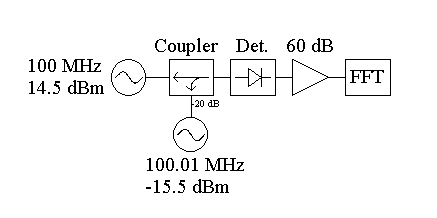Crystal oscillator amplitude noise is relatively unimportant in most applications. For many oscillators the AM noise is equal to or below the PM noise and in most systems the deleterious effect of AM noise is much lower than PM noise. Most oscillators serve as timekeepers or as frequency control devices and variations in the amplitude of the signal are less important than frequency fluctuations. However, AM noise can become important in high performance systems where the designer is struggling for every dB of performance and non-linear devices such as mixers and frequency multipliers can convert amplitude noise to phase noise and the end-use of the signal may be amplitude sensitive.
Amplitude noise may originate from different sources within the oscillator. Simple additive noise will be contributed by the output stages, typically adding equally to the phase and amplitude noise. The noise on each side of the carrier will typically be equal but uncorrelated and when these sidebands are folded together by an AM or PM detector; the noise powers simply add. Correlated sidebands arise from various modulation mechanisms. Non-linear or limiting output stages may be sensitive to the power supply, directly modulating power supply noise onto the amplitude of the oscillator. An AGC circuit can modulate noise onto the signal and various amplitude limiting mechanisms can similarly degrade the amplitude spectrum. Audio noise within the oscillator may modulate various parameters causing frequency or amplitude modulation, translating the audio noise up to the carrier frequency.
Generally speaking, the various modulation mechanisms contribute unequally to the amplitude and phase noise sidebands and the resulting phase relationship between the sidebands is arbitrary. Consequently, the assumptions made when measuring phase or amplitude noise should be evaluated against the end-use. As an example, consider an AM noise measurement of -120 dBc at 1 kHz offset. Since a simple AM detector combines both sidebands, one is tempted to simply subtract 3 dB from the readings to determine the single-sideband noise yielding -123 dBc. (The noise powers simply add.) But if the sidebands are in phase and correlated, then the noise voltages add and the correction factor is 6 dB giving -126 dBc, a significantly lower noise level. Unfortunately, direct measurement of single-sideband noise is difficult, especially in state-of-the-art oscillators. The 3 dB assumption is common and the single-sideband phase noise, script L(f), is defined as 1/2 of the double-sideband noise, thus skirting the measurement issue while providing a somewhat conservative number.
The AM noise for a Wenzel Associates ultra-low noise 100 MHz oscillator (Model # 500-06058A) and the LNVQ frequency multiplier, a VHF X4 multiplier, was measured using an ordinary diode detector and FFT audio spectrum analyzer. The detector was calibrated by injecting a sideband near the carrier frequency as shown in the oscillator test setup shown below:

The chart below shows the AM noise measured at the output of the oscillator and multiplier.
| 100 Hz | 1 kHz | 10 kHz | 100 kHz | |
| 100 MHz Oscillator | -153 dBc | -164 dBc | -177 dBc | -178 dBc |
| LVFQ Multiplier | -150 dBc | -158 dBc | -163 dBc | -164 dBc |
The indicated values assume that the detector combines equal, uncorrelated sidebands (3 dB was subtracted from the measured value). The detector was constructed using Schottky diodes selected for low noise. Detector flatness was verified to 100 kHz.